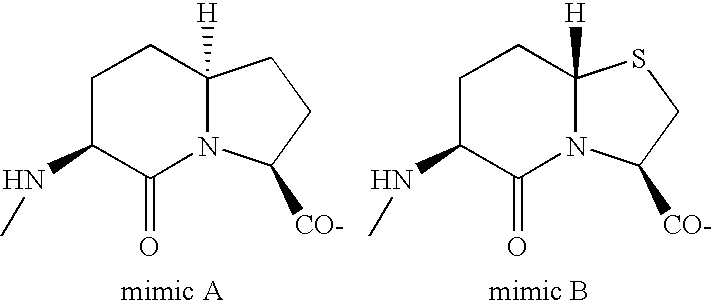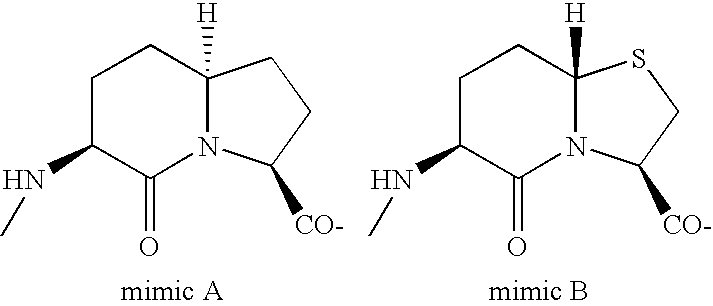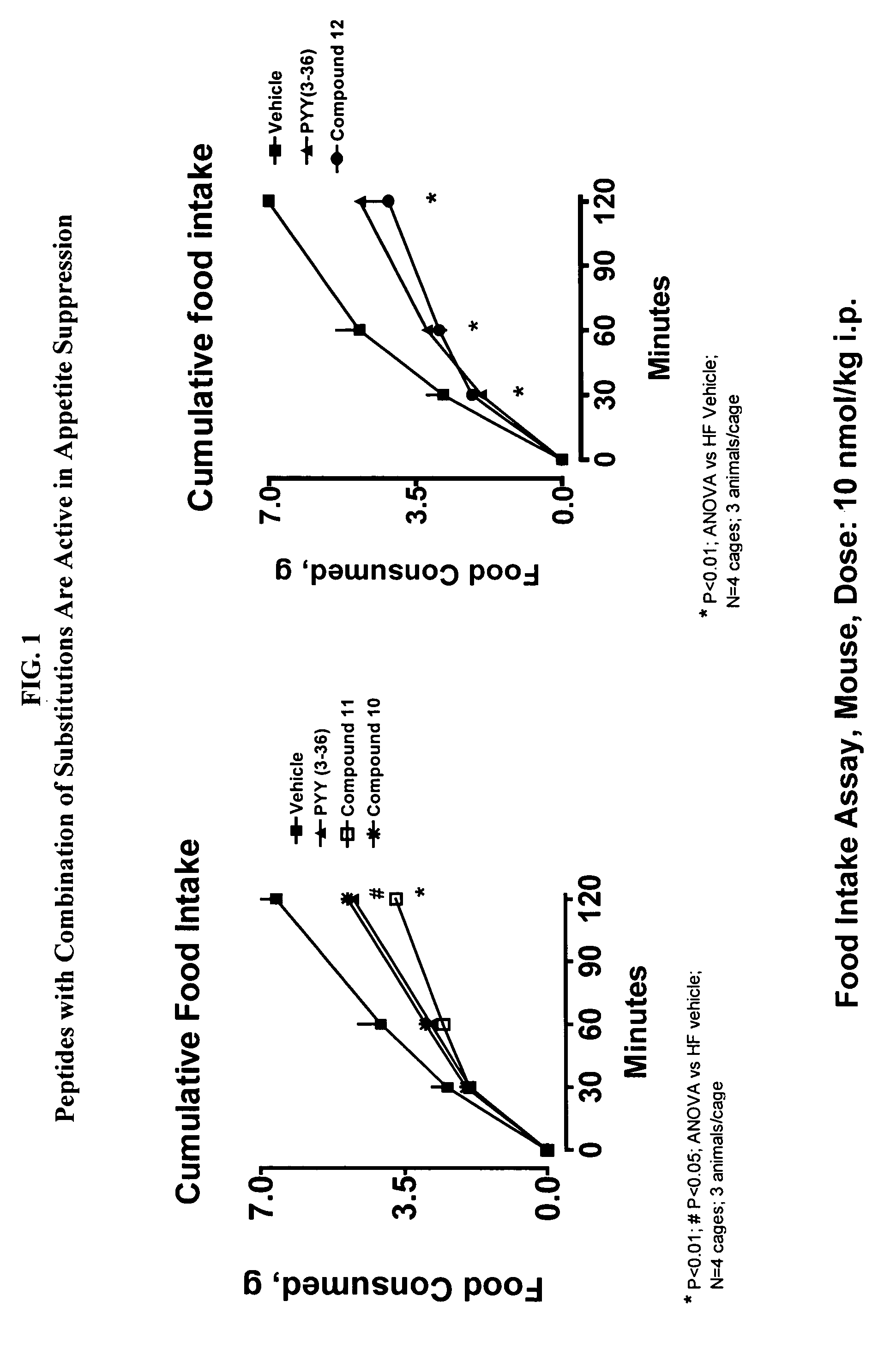Pancreatic polypeptide family motifs and polypeptides comprising the same
- Summary
- Abstract
- Description
- Claims
- Application Information
AI Technical Summary
Benefits of technology
Problems solved by technology
Method used
Image
Examples
example 1
Preparation of PPF Polypeptides
[0365] Peptides of the invention may be assembled on a Symphony peptide synthesizer (Protein Technologies, Inc.) using Rink amide resin (Novabiochem) with a loading of 0.43-0.49 mmol / g at 0.050-0.100 mmol. Fmoc amino acid (5.0 eq, 0.250-.500 mmol) residues are dissolved at a concentration of 0.10 M in 1-methyl-2-pyrrolidinone. All other reagents (HBTU, 1-hydroxybenzotriazole hydrate and N,N-Diisopropylethylamine) are prepared as 0.55 M dimethylformamide solutions. The Fmoc protected amino acids are then coupled to the resin-bound amino acid using, HBTU (2.0 eq, 0.100-0.200 mmol), 1-hydroxybenzotriazole hydrate (1.8 eq, 0.090-0.18 mmol), N,N-diisopropylethylamine (2.4 eq, 0.120-0.240 mmol) for 2 hours. Following the last amino acid coupling, the peptide is deprotected using 20% (v / v) piperidine in dimethylformamide for 1 hour. Once peptide sequence is complete, the Symphony peptide synthesizer is programmed to cleave the resin. Trifluoroacetic acid (TF...
example 2
PPF Polypeptides Suppress Food Intake in Food Intake Assay
[0374] Female NIH / Swiss mice (8-24 weeks old) are group housed with a 12:12 hour light:dark cycle with lights on at 0600. Water and a standard pelleted mouse chow diet are available ad libitum, except as noted. Animals are fasted starting at approximately 1500 hrs, 1 day prior to experiment. The morning of the experiment, animals are divided into experimental groups. In a typical study, n=4 cages with 3 mice / cage.
[0375] At time=0 min, all animals are given an intraperitoneal injection of vehicle or compound in an amount ranging from about 10 nmol / kg to 100 nmol / kg, and immediately given a pre-weighed amount (10-15 g) of the standard chow. Food is removed and weighed at 30, 60, and 120 min to determine the amount of food consumed (Morley, Flood et al., Am. J. Physiol. 267: R178-R184, 1994). Food intake is calculated by subtracting the weight of the food remaining after the e.g., 30, 60, 120, 180 and / or 240 minute time point ...
example 3
PPF Polypeptides Decrease Body Weight Gain in High Fat Fed (Diet-Induced-Obesity or DIO) C57BL / 6 Mice and High Fat-Fed HSD Rats
[0377] Mice: Male C57BL / 6 mice (4 weeks old at start of study) are fed high fat (HF, 58% of dietary kcal as fat) or low fat (LF, 11% of dietary kcal as fat) chow. After 4 weeks on chow, each mouse is implanted with an osmotic pump (Alzet # 2002) that subcutaneously delivers a predetermined dose of PPF polypeptide continuously for two weeks. Body weight and food intake are measured weekly (Surwit et al., Metabolism—Clinical and Experimental, 44: 645-51, 1995). Effects of the test compound are expressed as the mean ± sd of % body weight change (i.e., % change from starting weight) of at least 14 mice per treatment group (p<0.05 ANOVA, Dunnett's test, Prism v. 2.01, GraphPad Software Inc., San Diego, Calif.).
[0378] Rats: The night before treatment, male Sprague-Dawley® rats (average weight=415) consuming a high fat diet (45% kCal from fat) were assigned to tw...
PUM
| Property | Measurement | Unit |
|---|---|---|
| Volume | aaaaa | aaaaa |
| Volume | aaaaa | aaaaa |
| Volume | aaaaa | aaaaa |
Abstract
Description
Claims
Application Information
 Login to View More
Login to View More - R&D
- Intellectual Property
- Life Sciences
- Materials
- Tech Scout
- Unparalleled Data Quality
- Higher Quality Content
- 60% Fewer Hallucinations
Browse by: Latest US Patents, China's latest patents, Technical Efficacy Thesaurus, Application Domain, Technology Topic, Popular Technical Reports.
© 2025 PatSnap. All rights reserved.Legal|Privacy policy|Modern Slavery Act Transparency Statement|Sitemap|About US| Contact US: help@patsnap.com



